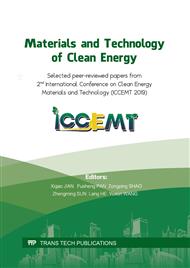[1]
K. Saeidi, X. Gao, F. Lofaj, L. Kvetková, Z.J. Shen, Transformation of austenite to duplex austenite-ferrite assembly in annealed stainless steel 316L consolidated by laser melting. J. Alloys Comp., 633 (2015), 463-469.
DOI: 10.1016/j.jallcom.2015.01.249
Google Scholar
[2]
D. Herzog, V. Seyda, E. Wycisk, C. Emmelmann, Additive manufacturing of metals. Acta Mater. 117 (2016) 371-392.
DOI: 10.1016/j.actamat.2016.07.019
Google Scholar
[3]
D. Gu, W. Meiners, K. Wissenbach, R. Poprawe, Laser additive manufacturing of metallic components: materials, processes and mechanisms. International materials reviews. 57(3) (2012)133-164.
DOI: 10.1179/1743280411y.0000000014
Google Scholar
[4]
W.E. Frazier. Metal additive manufacturing: a review. Journal of Materials Engineering and Performance. 23(6) (2014) 1917-1928.
Google Scholar
[5]
S. Anderson. Final technical report on laser direct manufacturing (LDM) for nuclear power components. DOE-NE0000542, USDOE Office of Nuclear Energy (2015).
DOI: 10.2172/1233481
Google Scholar
[6]
A. Riemer, S. Leuders, M. Thöne, H. Richard, T. Tröster, T. Niendorf, On the fatigue crack growth behavior in 316L stainless steel manufactured by selective laser melting. Engineering Fracture Mechanics 120 (2014) 15-25.
DOI: 10.1016/j.engfracmech.2014.03.008
Google Scholar
[7]
B. Verlee, T. Dormal, J. Lecomte-Beckers, Density and porosity control of sintered 316L stainless steel parts produced by additive manufacturing. Powder Metallurgy 55(4) (2012) 260-267.
DOI: 10.1179/0032589912z.00000000082
Google Scholar
[8]
I. Tolosa, F. Garciandía, F. Zubiri, F. Zapirain, A. Esnaola, Study of mechanical properties of AISI 316 stainless steel processed by selective laser melting,, following different manufacturing strategies. The International Journal of Advanced Manufacturing Technology 51(5-8) (2010) 639-647.
DOI: 10.1007/s00170-010-2631-5
Google Scholar
[9]
Y.M. Wang, T. Voisin, J.T. McKeown, J. Ye, N.P. Calta, Z. Li, Z. Zeng, Y. Zhang, W. Chen, T.T. Roehling, Additively manufactured hierarchical stainless steels with high strength and ductility. Nat.Mater. 17(1) (2018) 63.
DOI: 10.1038/nmat5021
Google Scholar
[10]
Y. Zhong, L.-E. Rännar, S. Wikman, A. Koptyug, L. Liu, D. Cui, Z. Shen, Additive manufacturing of ITER first wall panel parts by two approaches: Selective laser melting and electron beam melting. Fusion Eng. Des. 116 (2017) 24-33.
DOI: 10.1016/j.fusengdes.2017.01.032
Google Scholar
[11]
Y. Zhong, L. Liu, S. Wikman, D. Cui, Z. Shen, Intragranular cellular segregation network structure strengthening 316L stainless steel prepared by selective laser melting. Journal of Nuclear Materials.470 (2016) 170-178.
DOI: 10.1016/j.jnucmat.2015.12.034
Google Scholar
[12]
M. Song, M. Wang, X. Lou, et al. Radiation damage and irradiation-assisted stress corrosion cracking of additively manufactured 316L stainless steels. Journal of Nuclear Materials. 513(2019) 33-44.
DOI: 10.1016/j.jnucmat.2018.10.044
Google Scholar
[13]
Design Construction Rules Mechanical Components PWR Nuclear Power Plant.
Google Scholar
[14]
ASTM E837-08, Standard Test Method for Determining Residual Stresses by the Hole-Drilling Strain-Gage Method, ASTM International, West Conshohocken, PA, (2008).
DOI: 10.1520/e0837-01e01
Google Scholar
[15]
ISO 3651-2: Determination of resistance to intergranular corrosion of stainless steels - Part 2: Ferritic, austenitic and ferritic-austenitic (duplex) stainless steels - Corrosion test in media containing sulfuric acid. ISO 3651-2:1998, International Standards Organization.
DOI: 10.3403/01427645
Google Scholar
[16]
P. Zhu, J-G. Zhao, L. Lu. Et al. Effect of Solution Treatment on Microstructure and Grain Boundary Distribution of 316L Stainless Steel Formed by Selective Laser Melting (SLM). Materials Science and Engineering, 44(2019) 121-132.
Google Scholar
[17]
W. M. Tucho, V. H. Lysne, H. Austbø, et al. Investigation of effects of process parameters on microstructure and hardness of SLM manufactured SS316L. Journal of Alloys and Compounds. 740(2018) 910-925.
DOI: 10.1016/j.jallcom.2018.01.098
Google Scholar
[18]
I. Yadroitsev, I. Yadroitsava. Evaluation of residual stress in stainless steel 316L and Ti6Al4V samples produced by selective laser melting. Virtual and Physical Prototyping, 10(2) (2015) 1-10.
DOI: 10.1080/17452759.2015.1026045
Google Scholar


